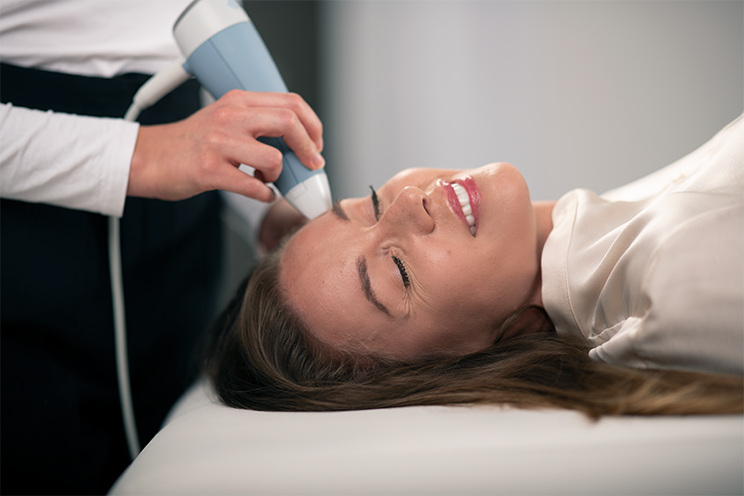Auringon aiheuttamat ihovauriot ja rypyt

Auringon säteily on tärkeää D-vitamiinin tuotannolle ja mielialan parantamiselle, mutta liiallinen altistuminen voi aiheuttaa vakavia iho-ongelmia. Näitä ovat ennenaikaiset rypyt, ihon kuivuminen ja pigmenttimuutokset, jotka tunnetaan aurinkovaurioina.
Ihon pitkäaikainen altistuminen UV-säteilylle hajottaa kollageenia ja elastiinia, jotka ylläpitävät ihon kiinteyttä ja kimmoisuutta. Tämän seurauksena iho menettää kimmoisuuttaan ja näyttää väsyneeltä ja samealta. Auringon vaurioittama iho kärsii myös suuremmasta veltostumisesta, jolloin kasvojen ilme muuttuu vähemmän jänteväksi ja muun muassa leukalinja ja kaulan iho voivat muuttua löysemmiksi.
Aurinkovaurioita ilmenee myös kasvojen erityisillä alueilla, kuten silmien ympärillä ja otsalla, joissa iho on erityisen herkkä. Otsarypyt, naururypyt ja ns. sibeliusrypyt syntyvät useimmiten juuri näihin kohtiin. Vahingoittunut iho menettää kosteustasapainonsa, mikä voi edistää myös akuutteja ihon punoitustiloja ja muita epätasaisuuksia. Näiden kosmeettisten muutosten lisäksi auringon aiheuttama ihovaurio voi johtaa vakaviin ihomuutoksiin, kuten ihosyövän eri muotoihin, mukaan lukien melanooma, joka on ihosyövistä vaarallisin.
Miten UV-säteily vanhentaa ihoa?
Auringon aiheuttamat ihovauriot johtuvat ensisijaisesti UVA- ja UVB-säteilystä. Nämä säteilytyypit vaikuttavat ihoon eri tavoin, mutta molemmat voivat olla tuhoisia pitkällä aikavälillä. UVA-säteet tunkeutuvat syvälle ihon kerroksiin ja hajottavat siellä kollageenia, mikä heikentää ihon kimmoisuutta ja nopeuttaa ryppyjen syntyä. UVB-säteet vaikuttavat pintakerrokseen aiheuttaen ihon palamista ja punoitusta, ja toistuva palaminen lisää riskiä ihosyövän kehittymiselle.
UV-säteilyn vaikutuksesta syntyvät vapaat radikaalit ovat toinen merkittävä syy ihon ennenaikaiselle ikääntymiselle. Nämä molekyylit aiheuttavat oksidatiivista stressiä, mikä hidastaa ihon uusiutumista ja rappeuttaa ihon rakennetta. Terve iho pystyy vastustamaan jonkin verran vapaiden radikaalien vaikutuksia, mutta pitkittynyt altistus UV-säteille kuluttaa ihon luonnollisia puolustusmekanismeja.
Erityisesti ikääntyvä iho ei enää pysty korjaamaan auringon aiheuttamia vaurioita yhtä tehokkaasti kuin nuorempi iho, mikä lisää veltostumista ja syvempiä ryppyjä kasvoille, kaulalle ja jopa käsiin. Lisäksi aurinko voi vaikuttaa negatiivisesti ihon kosteustasapainoon, mikä tekee ihosta alttiimman kuivumiselle, punoitukselle ja ärsytykselle.

Auringon aiheuttamien ihovaurioiden eri vaiheet
Auringon aiheuttamat ihovauriot ja rypyt voivat ilmetä eri tavoin ihon tyypistä, altistumisen määrästä ja henkilön ihonhoitorutiineista riippuen.
- Ensimmäiset merkit: Aurinkovauriot alkavat usein hienoina ryppyinä ja ihon lievänä kuivumisena, erityisesti kasvoilla, joissa aurinkoa on vaikea välttää. Pigmenttimuutokset, kuten epätasainen ihonsävy ja lievä punoitus, ovat myös ensimmäisiä merkkejä siitä, että iho alkaa kärsiä liiallisesta UV-altistuksesta.
- Keskivaikeat muutokset: Pitkäaikainen auringonvalolle altistuminen näkyy syvempinä ryppyinä, jotka korostuvat tietyillä kasvojen alueilla, kuten otsalla sekä silmien ja suun ympärillä. Tämä vaihe tuo näkyviin erityisesti sibeliusryppyjä ja syviä nasolabiaalijuonteita, jotka korostavat ikääntymisen merkkejä kasvoilla. Myös kaulan alueen ja leukalinjan veltostumista voi alkaa näkyä.
- Pitkälle edenneet vauriot: Pitkäkestoiset aurinkovauriot johtavat huomattaviin ihomuutoksiin ja syvempiin uurteisiin. Iho alkaa menettää selvästi joustavuuttaan ja kosteuttaan, ja vakavampia ryppyjä ilmenee erityisesti kasvojen herkimmillä alueilla. Nasolabiaalijuonteet, ylähuulen rypyt ja kaulan alueen juonteet syvenevät merkittävästi. Tällaisessa vaiheessa iho on erityisen altis solumuutoksille ja ihosyövän riski kasvaa huomattavasti, koska UV-säteet ovat heikentäneet ihon immuunijärjestelmää ja kykyä korjata vaurioituneita soluja.
Näiden eri vaiheiden ja vauriotyyppien ymmärtäminen on keskeistä auringon aiheuttamien ihovaurioiden ehkäisyssä ja hoidossa, sillä varhainen puuttuminen voi hidastaa ikääntymisen merkkien syntyä ja ehkäistä vakavampia ihomuutoksia.

Hoitomuodot auringon aiheuttamien ryppyjen ja ihovaurioiden hoitoon
Auringon aiheuttamia ryppyjä voidaan hoitaa useilla eri menetelmillä, jotka kiinteyttävät ihoa, vahvistavat kollageenin tuotantoa ja tukevat ihon elastiinirakenteita:
- EXION Clear RF: Uusi laserin kaltainen toimenpide nopealla toipumisajalla, jossa tekoälyllä toimiva järjestelmä varmistaa johdonmukaisen ja tasaisen mikroablaation, joka on räätälöity jokaiselle iholle. Tämä toimenpide tekee ihosta sileämmän, tasaisemman sävyisen ja poistaa auringon aiheuttamia pigmenttimuutoksia.
- EXION Fractional: Tässä hoidossa yhdistyvät monopolaarinen radiotaajuus RF ja tekoäly yhdistettynä mikroneulaukseen, jotta energiaa voidaan antaa tarkasti kasvojen ja vartalon ihon syvempiin kerroksiin. Sitä käytetään ihon kiristämiseen, ihon rakenteen parantamiseen ja fibroottisen kudoksen, kuten arpien korjaamiseen.
- EMFACE-hoito: Veitsetön ja moderni facelift-laitehoito ikääntymismuutoksiin hoitaa sekä kasvojen veltostunutta ihoa, että lihaksia. Tuloksena on kiinteämpi iho sekä ryppyjen, sibelius- ja nasolabiaalijuonteiden tasoittuminen.
- Hyaluronihappo: Lisää ihon kosteutusta ja täyteläisyyttä sekä auttaa pehmentämään pintaryppyjä ja säilyttämään ihon kimmoisuuden. Voidaan käyttää myös nasolabiaalijuonteiden täyttöön.
- PRP-hoito: Hyödyntää omaa verihiutaleseerumia aktivoimaan ihon uusiutumista. PRP korjaa UV-säteilyn aiheuttamia soluvaurioita, tehostaa kollageenin muodostusta ja häivyttää ryppyjä luonnollisesti.
- PRP + hyaluronihappo -hoito: Yhdistää PRP:n uudistavan vaikutuksen ja hyaluronihapon intensiivisen kosteutuksen. Tämä synergia palauttaa ihon kimmoisuutta ja kosteustasapainoa, vähentää auringon aiheuttamia vaurioita ja tekee ihosta sileämmän ja heleämmän.
- HIFU-hoito: Kohdistaa ultraäänienergian syvälle ihoon kiinteyttäen ja muotoillen kasvoja. Sopii erinomaisesti kasvojen kohotukseen ilman kirurgiaa.
- Kasvohoidot: Tukevat ihonhoitoa kokonaisvaltaisesti. Sisältävät usein kuorintoja, kosteutusta ja kiinteyttäviä aineita.
- Anti-agingvoiteet: Sisältävät antioksidantteja ja peptidiyhdisteitä, jotka tukevat ihon uusiutumista ja kosteutusta.
- Laserhoito: Poistaa aurinkovaurioita ja ihon epätasaisuuksia kohdistetun laserenergian avulla. Kohottaa ja tasoittaa ihoa tehokkaasti.
- Facelift (kasvojen kohotus): Kirurginen hoito, joka kohottaa ja kiinteyttää veltostunutta ihoa. Sopii etenkin selkeisiin ikääntymisen merkkeihin.
Näillä hoidoilla voidaan lieventää ja ehkäistä auringon aiheuttamia vaurioita sekä parantaa ihon ulkonäköä ja kimmoisuutta. Kuitenkin ennaltaehkäisy – erityisesti aurinkosuojan käyttö – on tärkein tekijä auringon aiheuttamien ryppyjen ja ihovaurioiden estämisessä.
MESQ®
DoctusPlus Oy:n aputoiminimi
Yritys
DoctusPlus Oy
Y-tunnus
3154088-6
Käyntiosoite
Itämerenkatu 11-13 F, 00180 Helsinki
Puhelin
Sähköposti
Aukioloajat
Ma – Pe 11:00 – 19:00